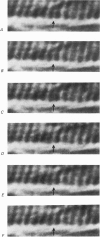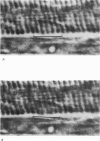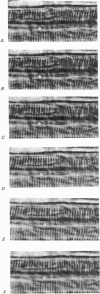Abstract
1. Frog sartorius muscle bathed in 1 mM-caffeine generates brief asynchronous contraction of individual sarcomeres, 'sarcomeric oscillations', and propagated contractile waves. 2. Analysis of cinematographic records shows that during sarcomeric oscillations the sarcomere length decreases and the distribution of sarcomere lengths is wider than in controls. 3. Caffeine can produce sarcomeric oscillations in K depolarized muscle fibres and, to a limited extent, in glycerol-treated muscle fibres. 4. Treatment of muscle with dantrolene sodium blocks production of sarcomeric oscillations by caffeine. 5. In caffeine-treated muscle fibres, electrically produced depolarization could initiate or increase the frequency of sarcomeric oscillations, and electrical hyperpolarization diminishes the frequency or stops sarcomeric oscillations. 6. Caffeine solution bathing a muscle undergoing sarcomeric oscillations (the perfusate), when applied to a fresh muscle, initiates sarcomeric oscillations with a relatively short latency. 7. An U.V.-absorbance peak at 245 nm develops in the caffeine solution bathing a muscle undergoing sarcomeric oscillations. 8. It was found that a contraction-regulating substance (oscillogen) is released from a muscle undergoing sarcomeric oscillations. From results of selective dialysis and gel permeation chromatography, the molecular weight of the oscillogen is estimated to be between 700-1000 daltons. 9. It is proposed that the oscillogen is a normally occurring substance which functions in excitation-contraction coupling at the T-tubule terminal cistern junction in skeletal muscle.
Full text
PDF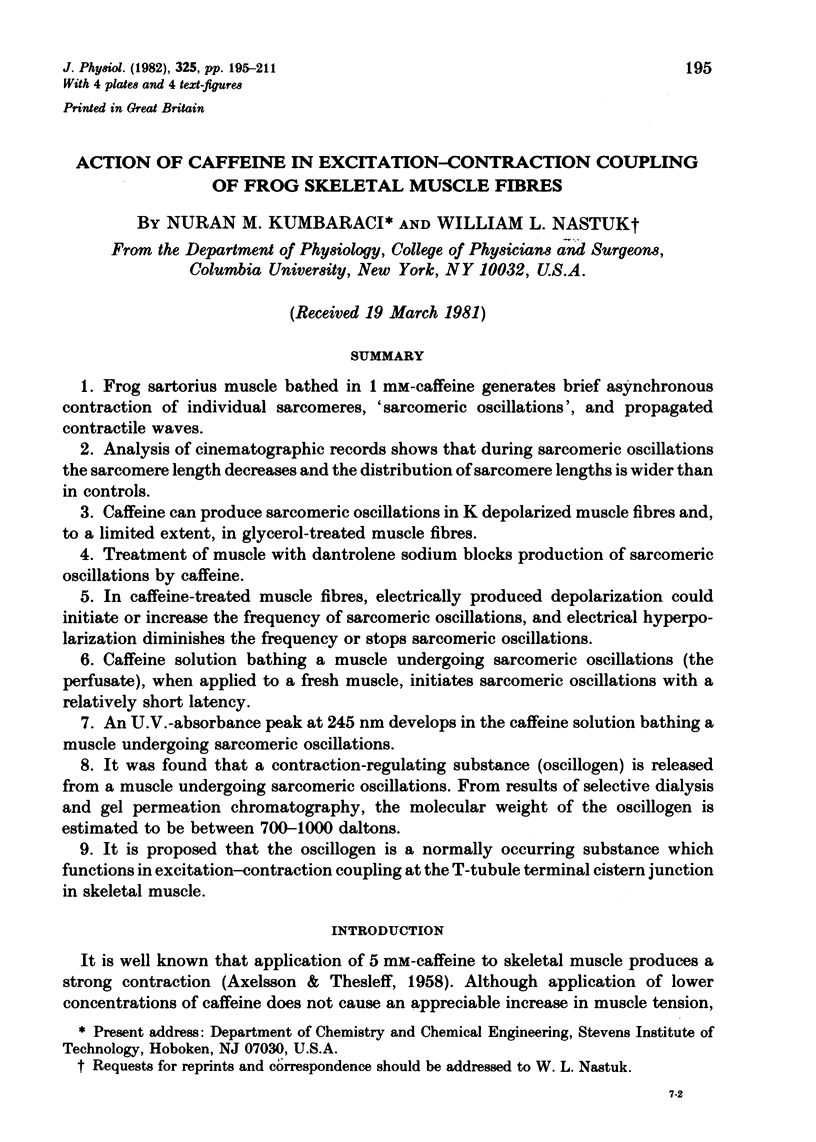
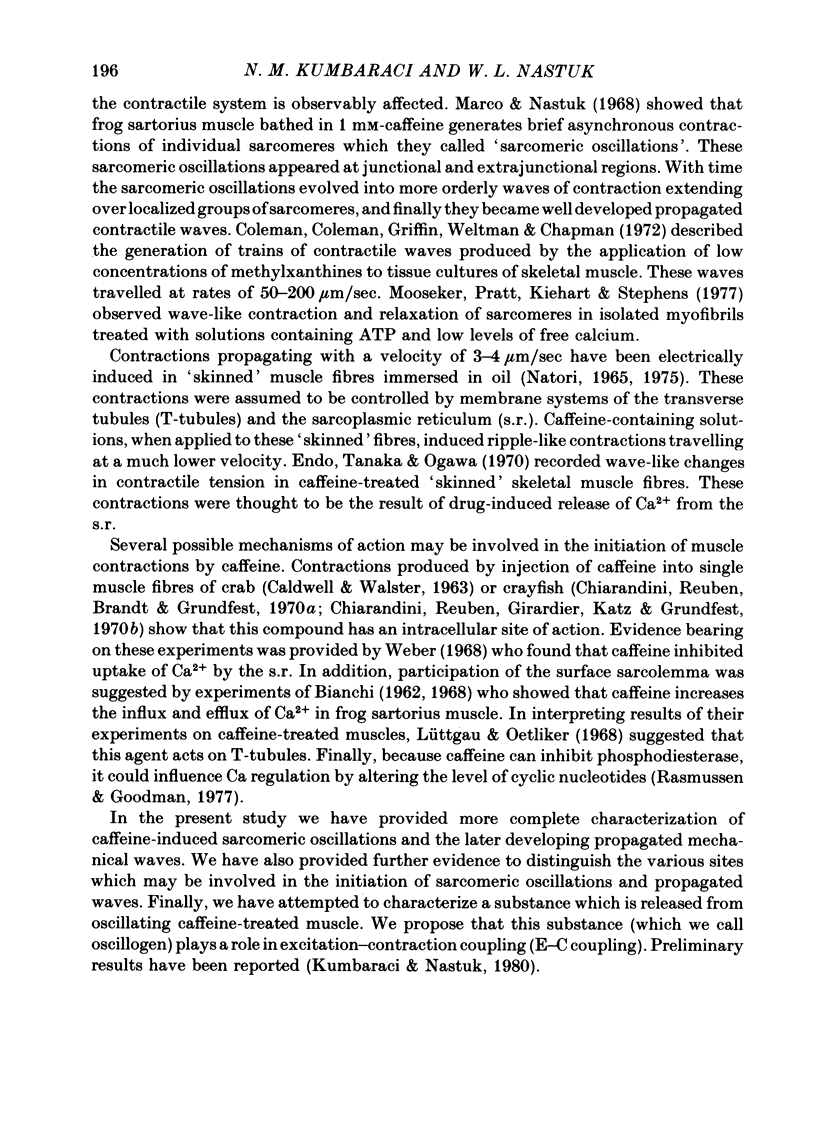
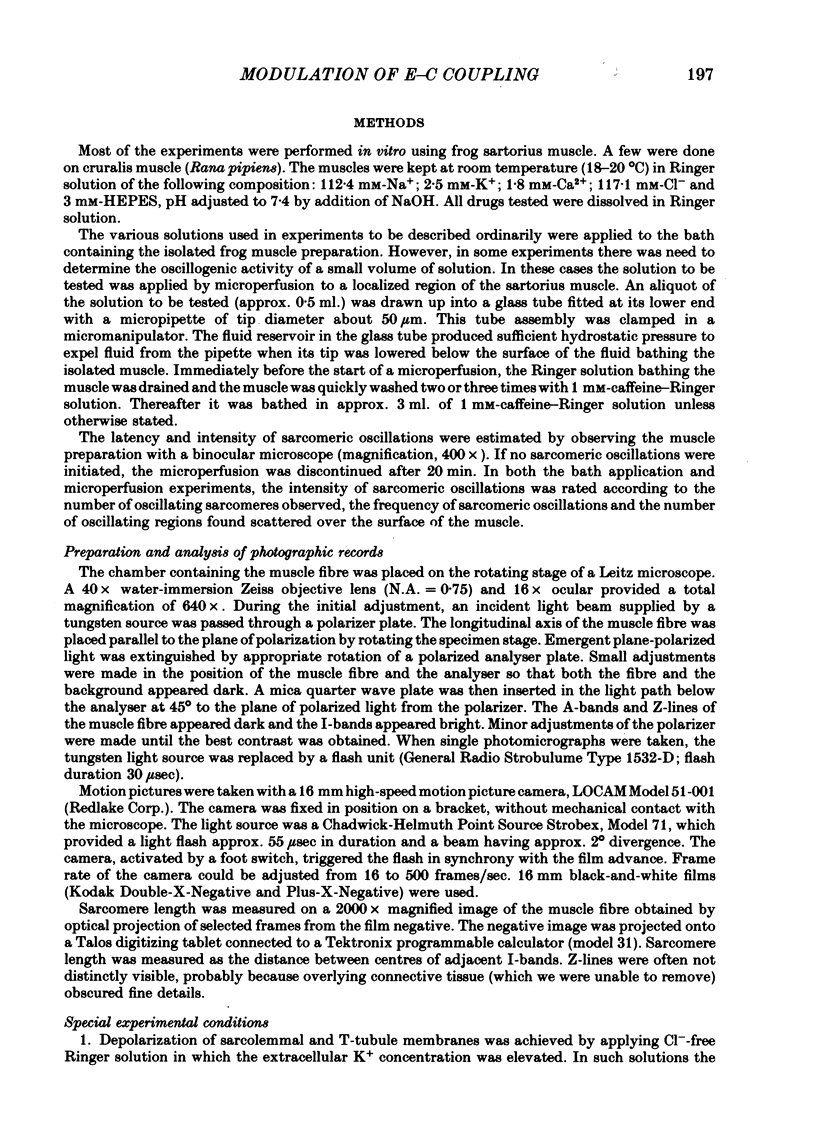
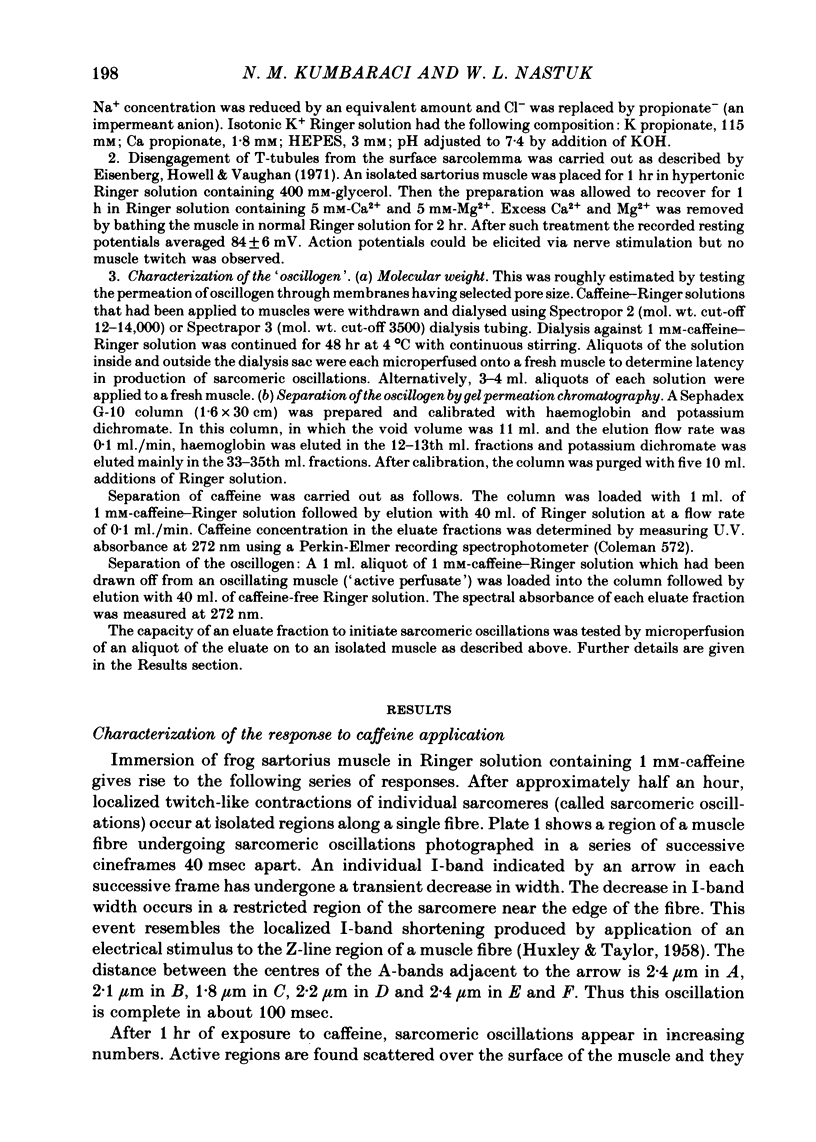
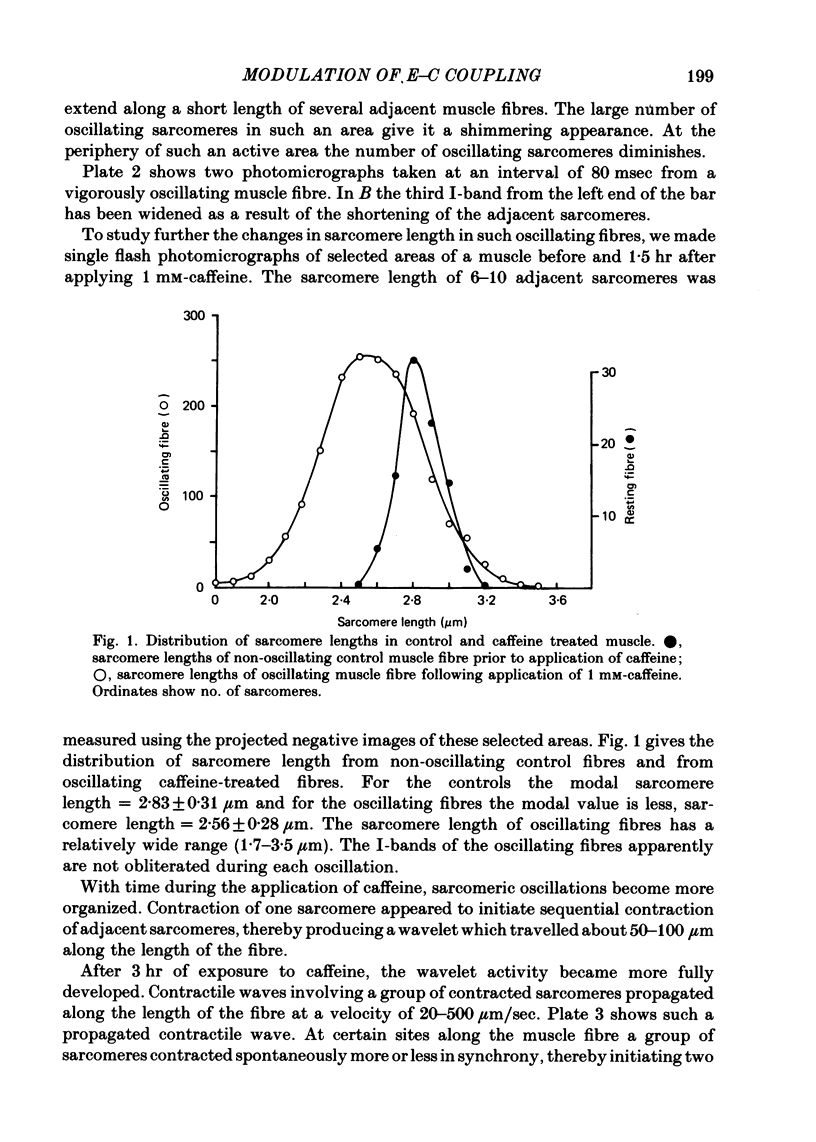
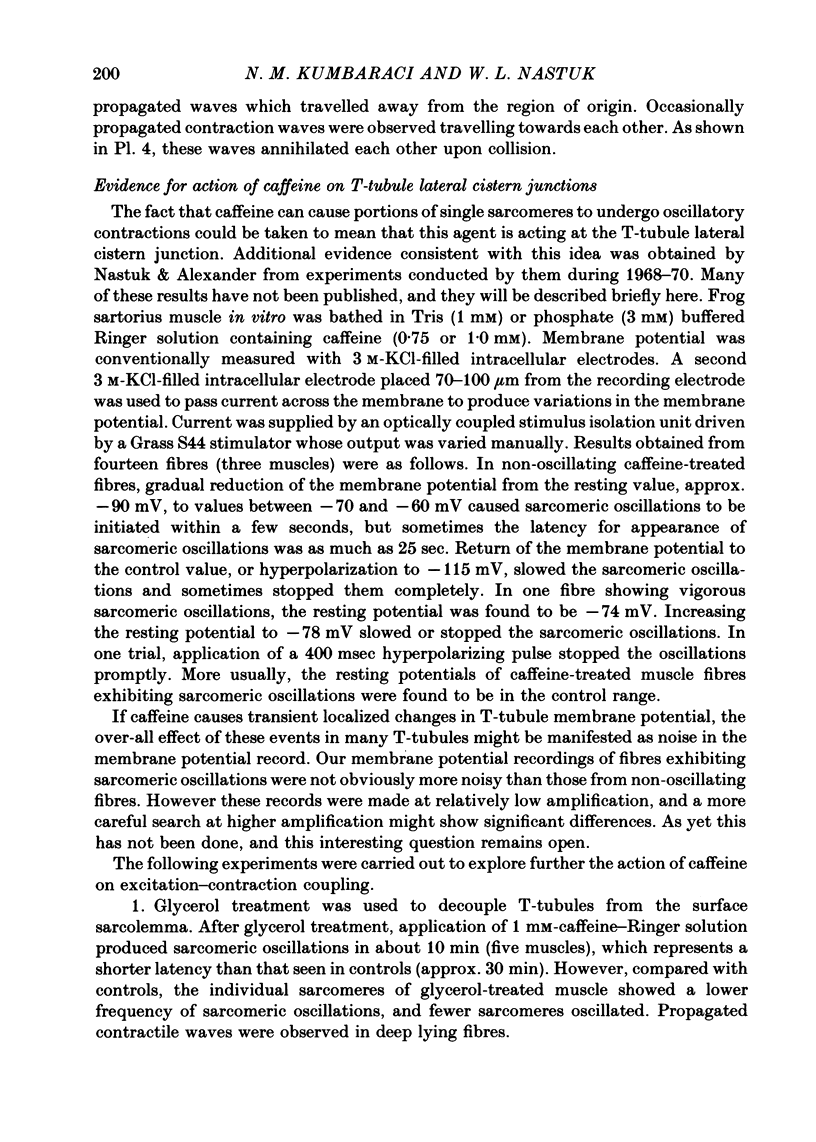
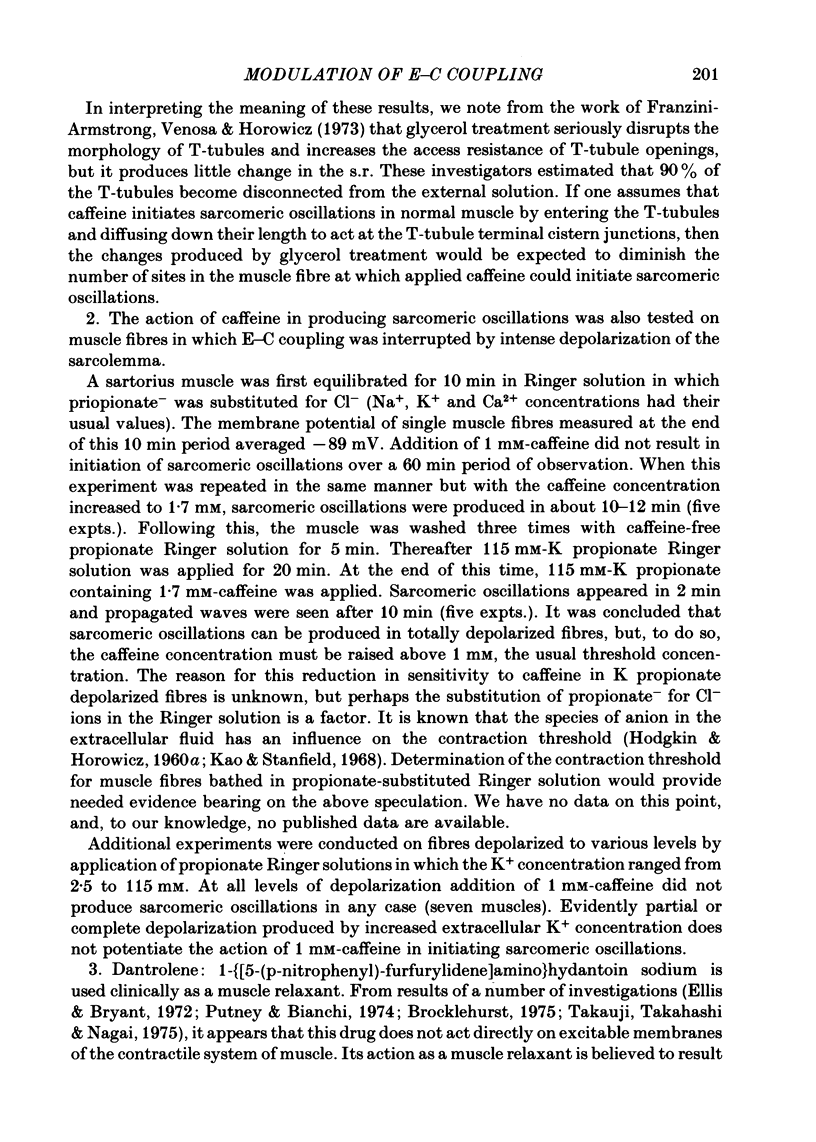
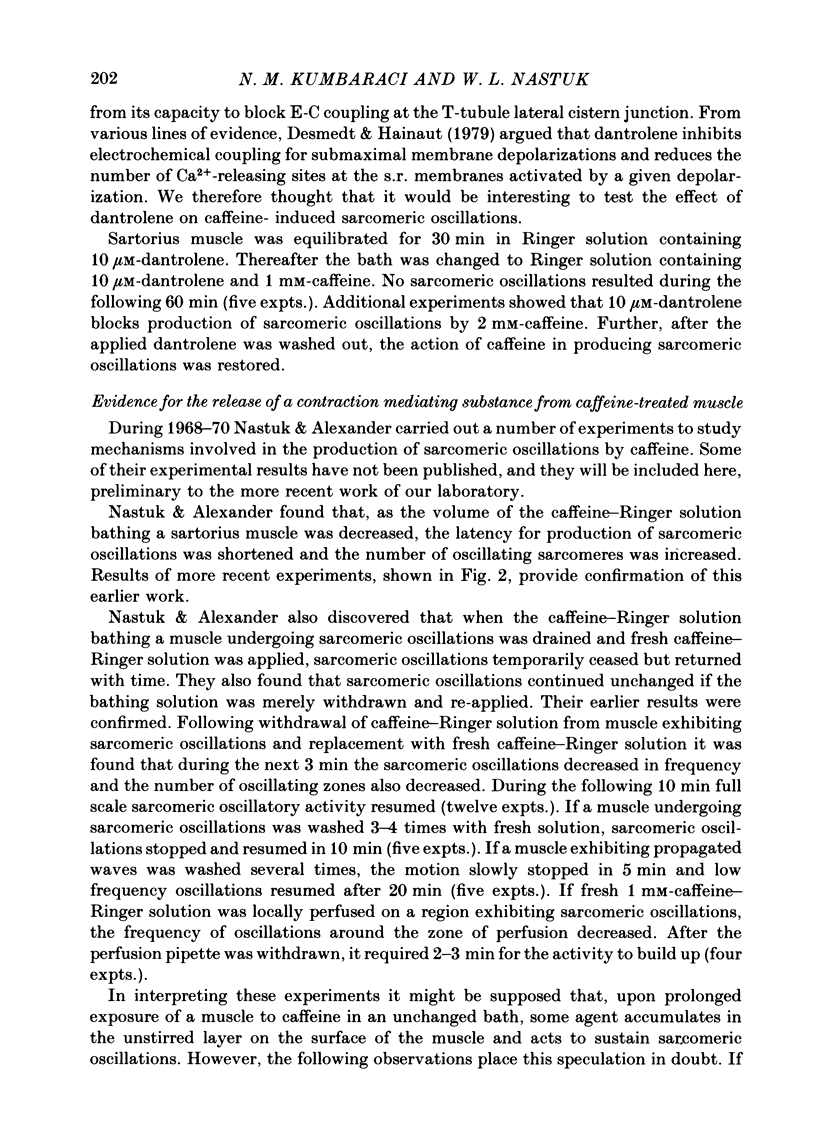
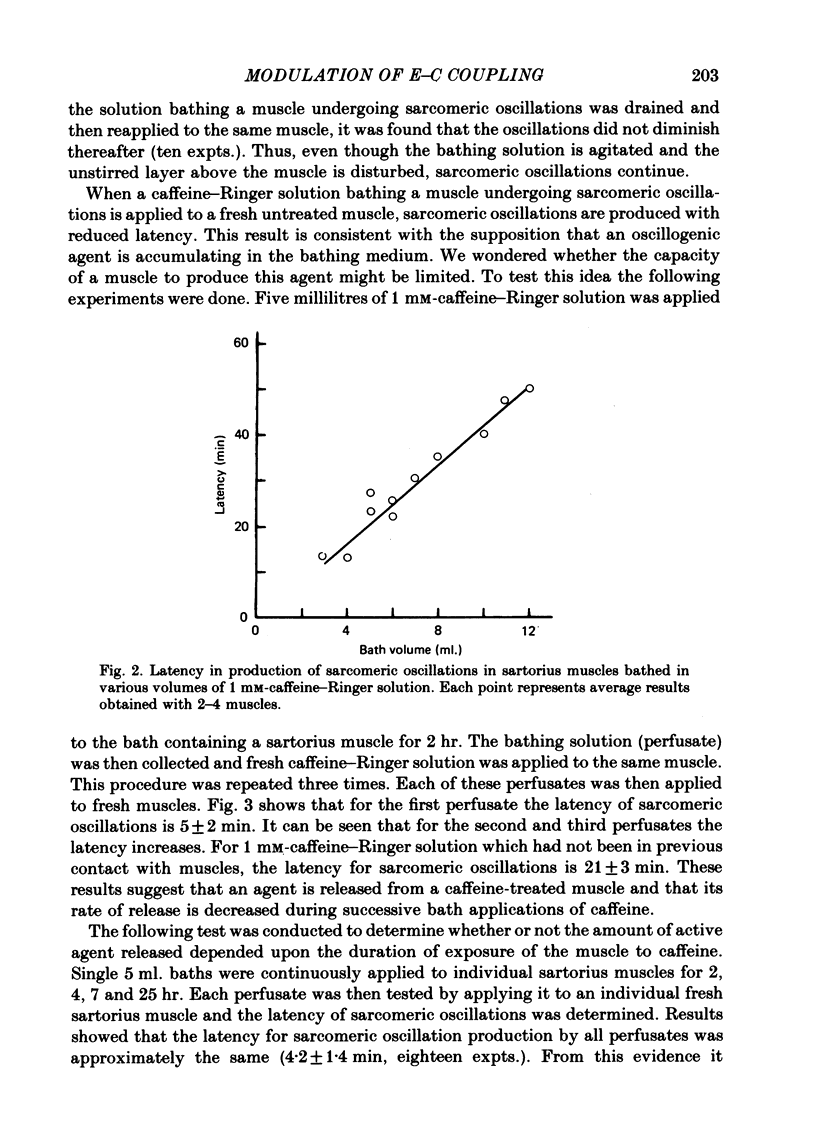
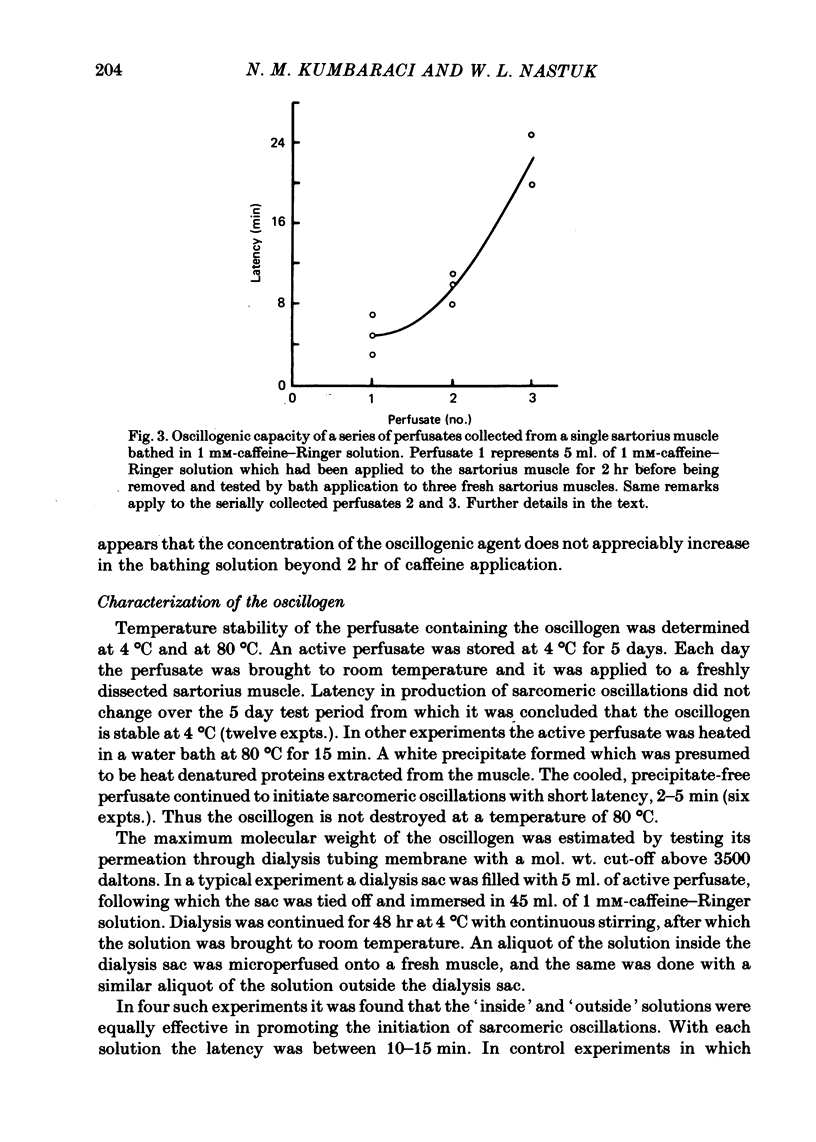
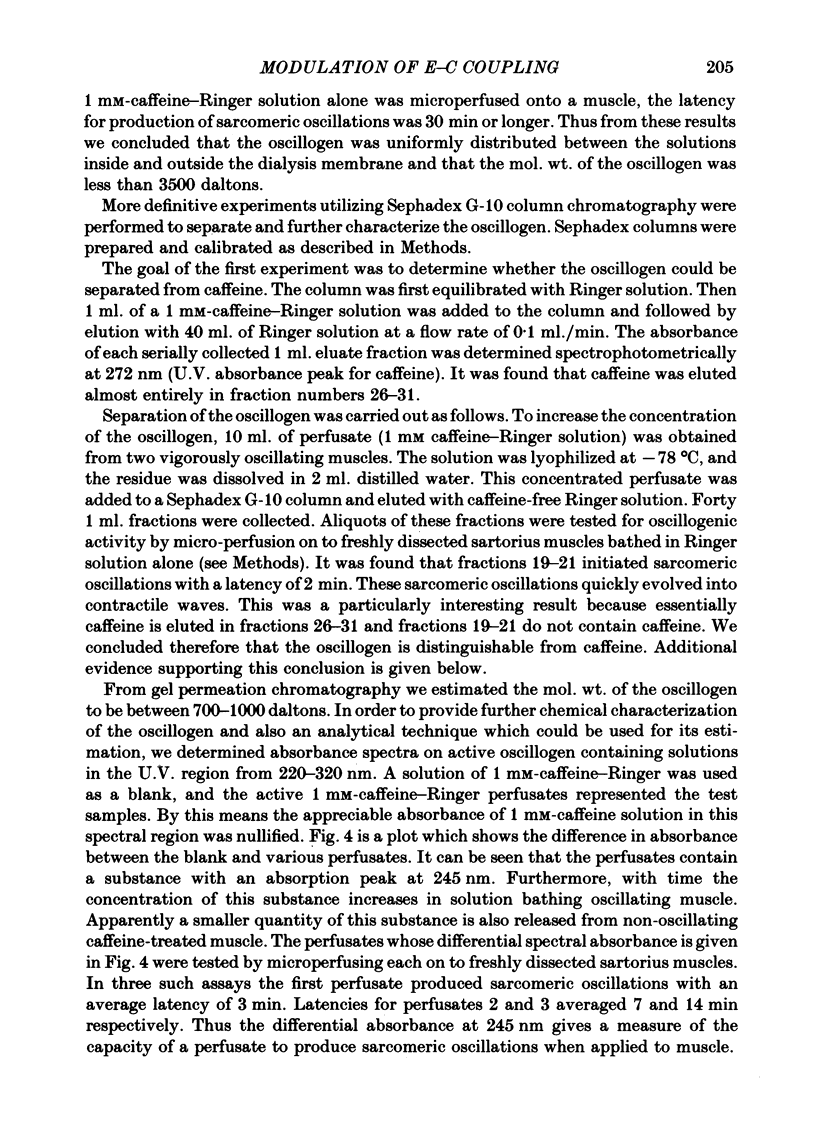
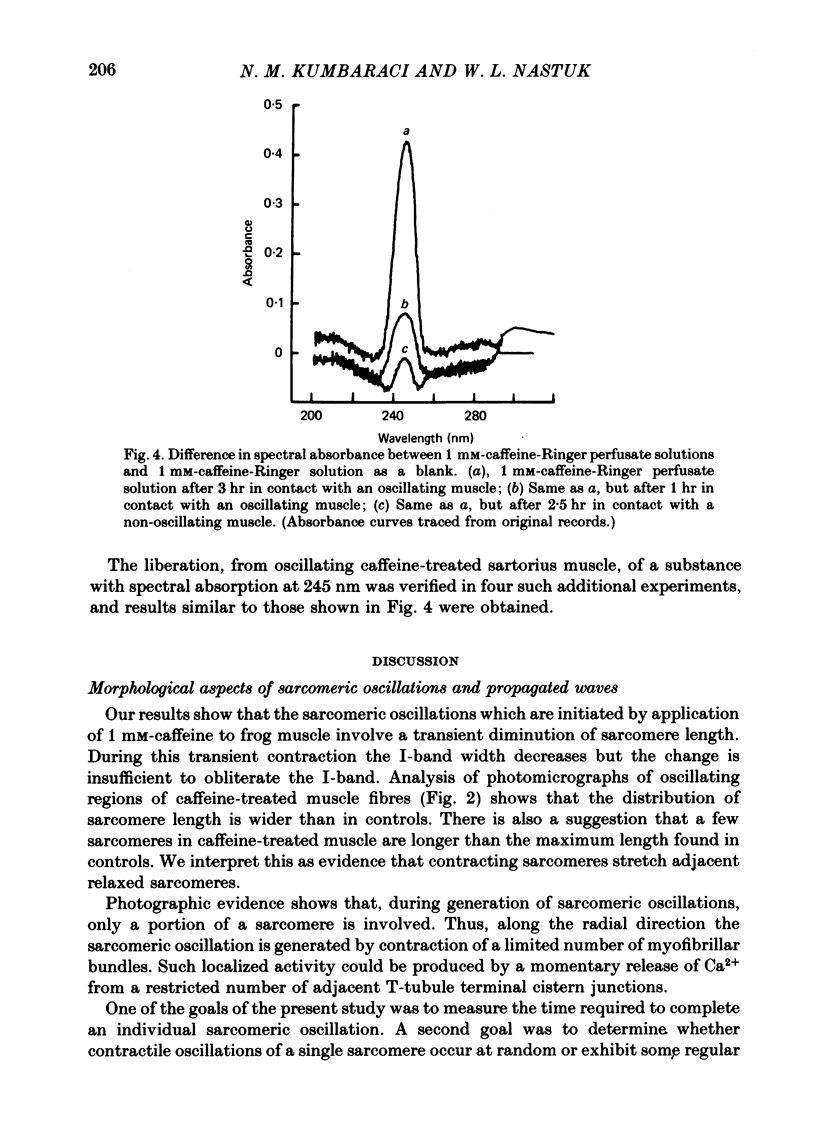
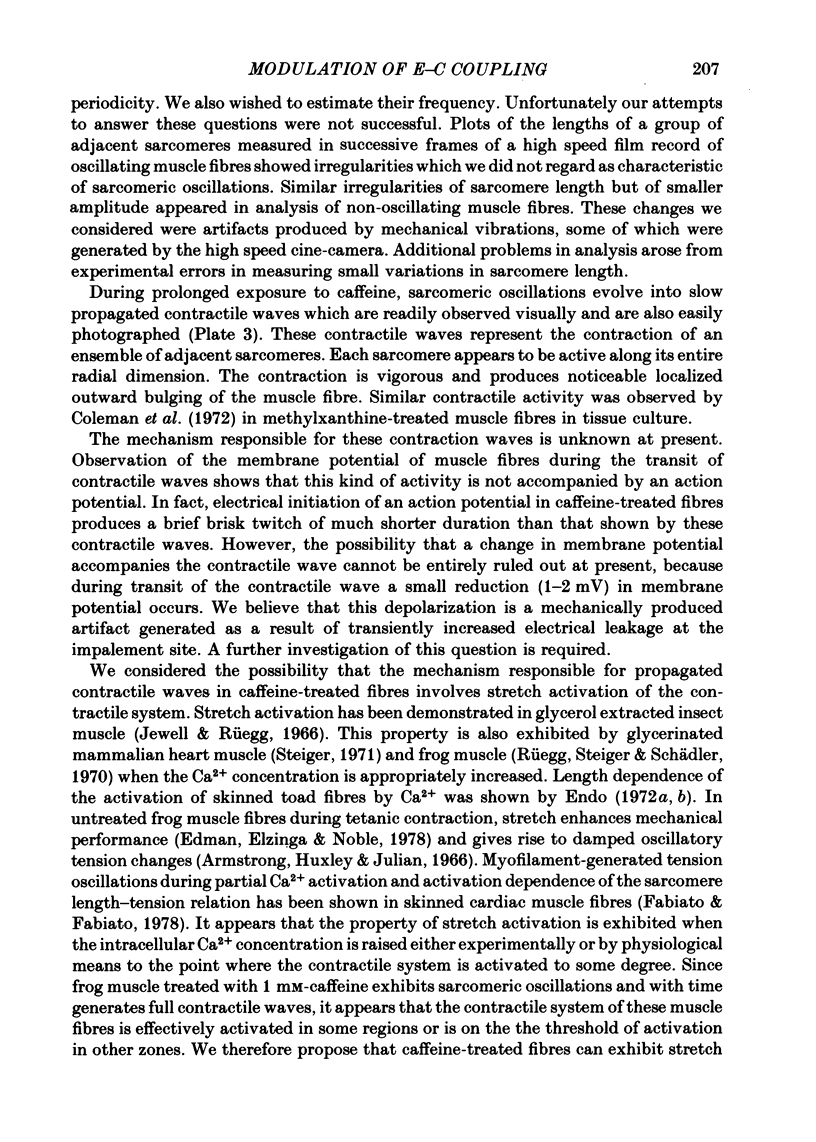
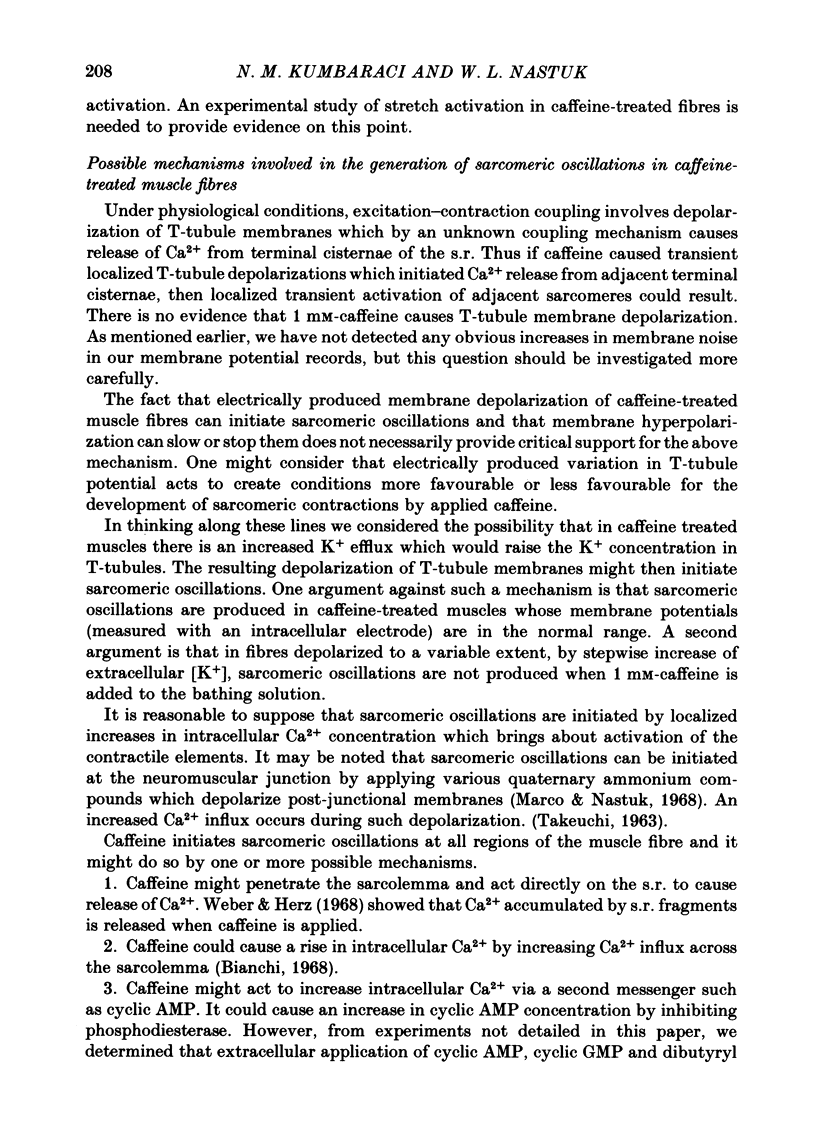
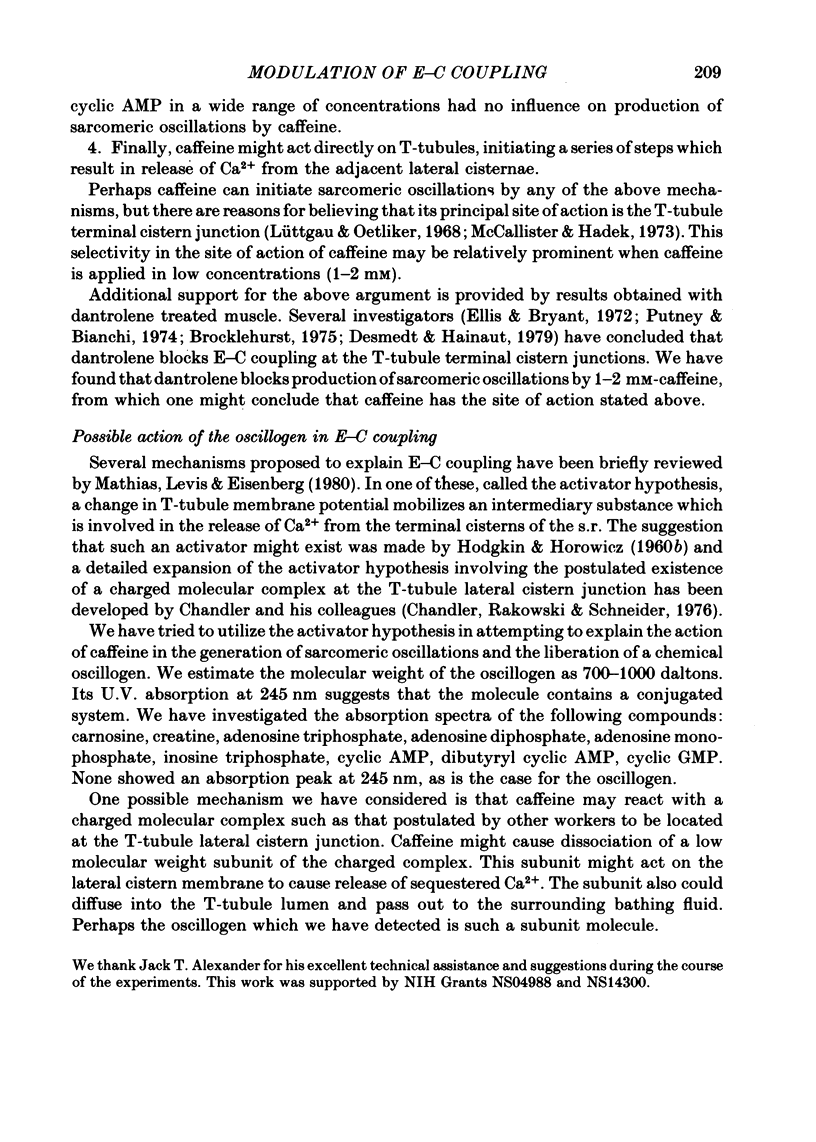
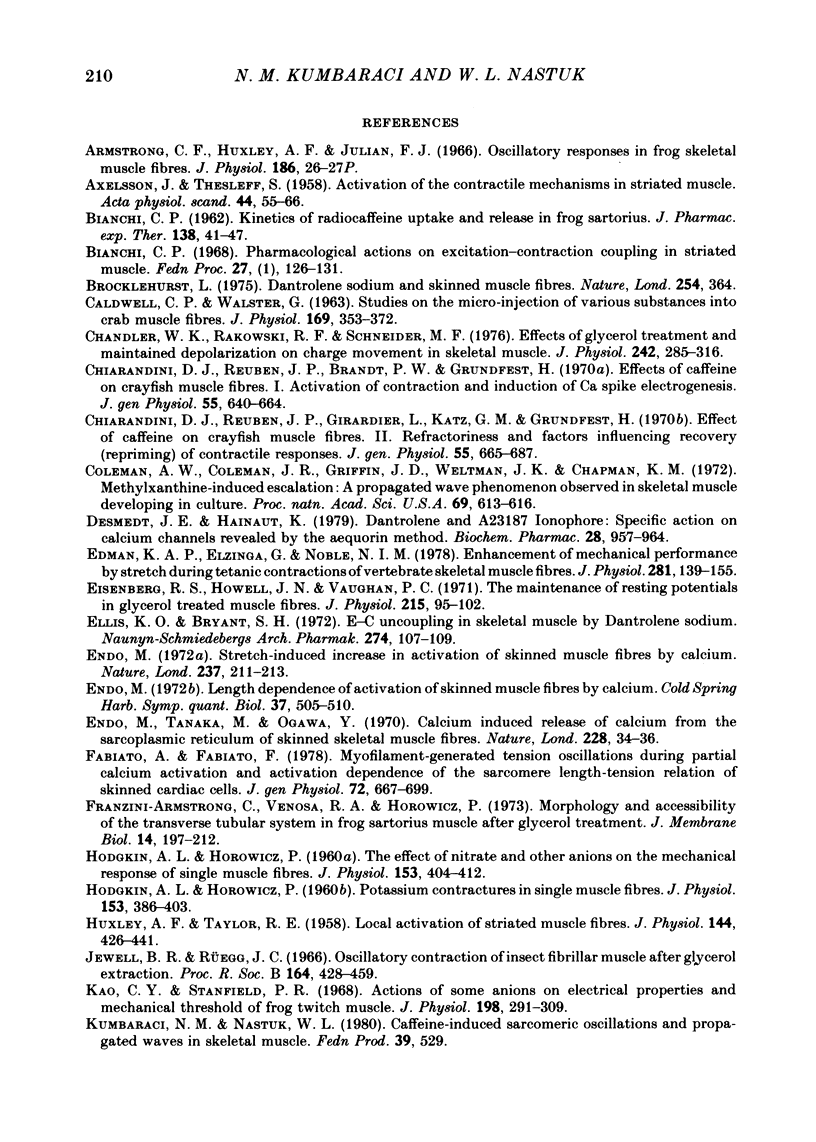
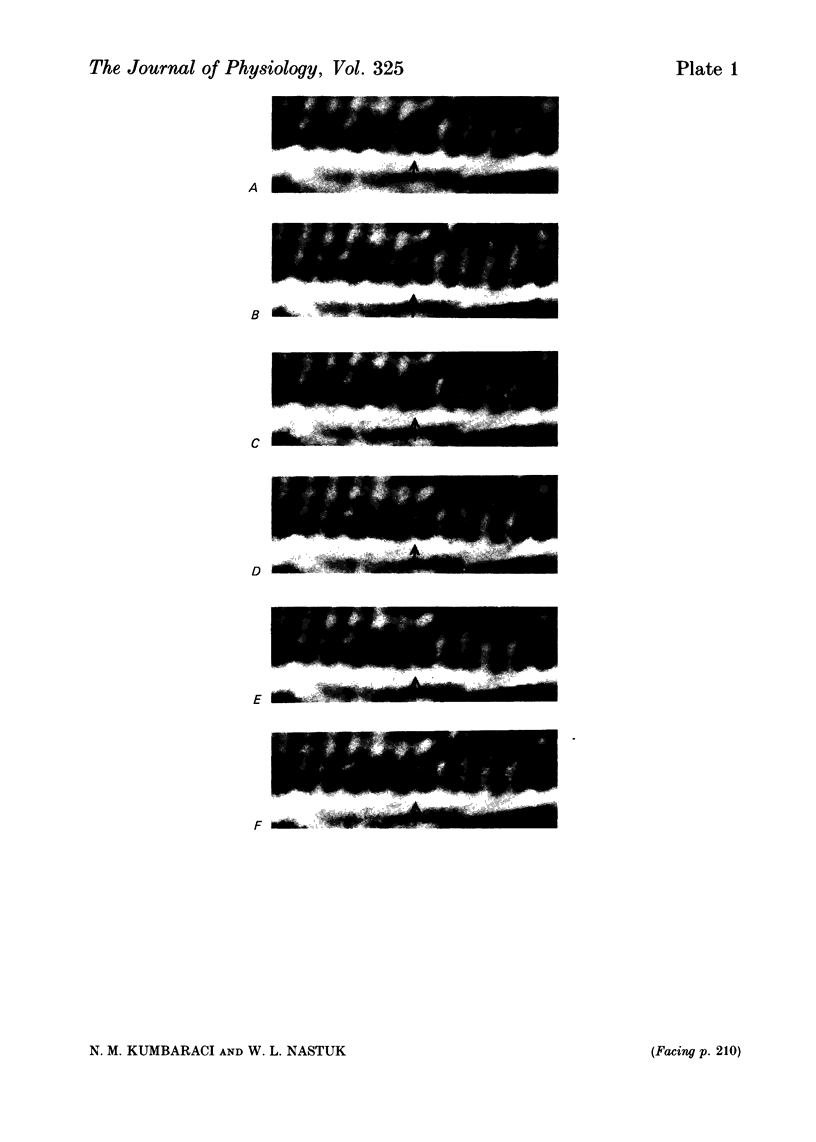
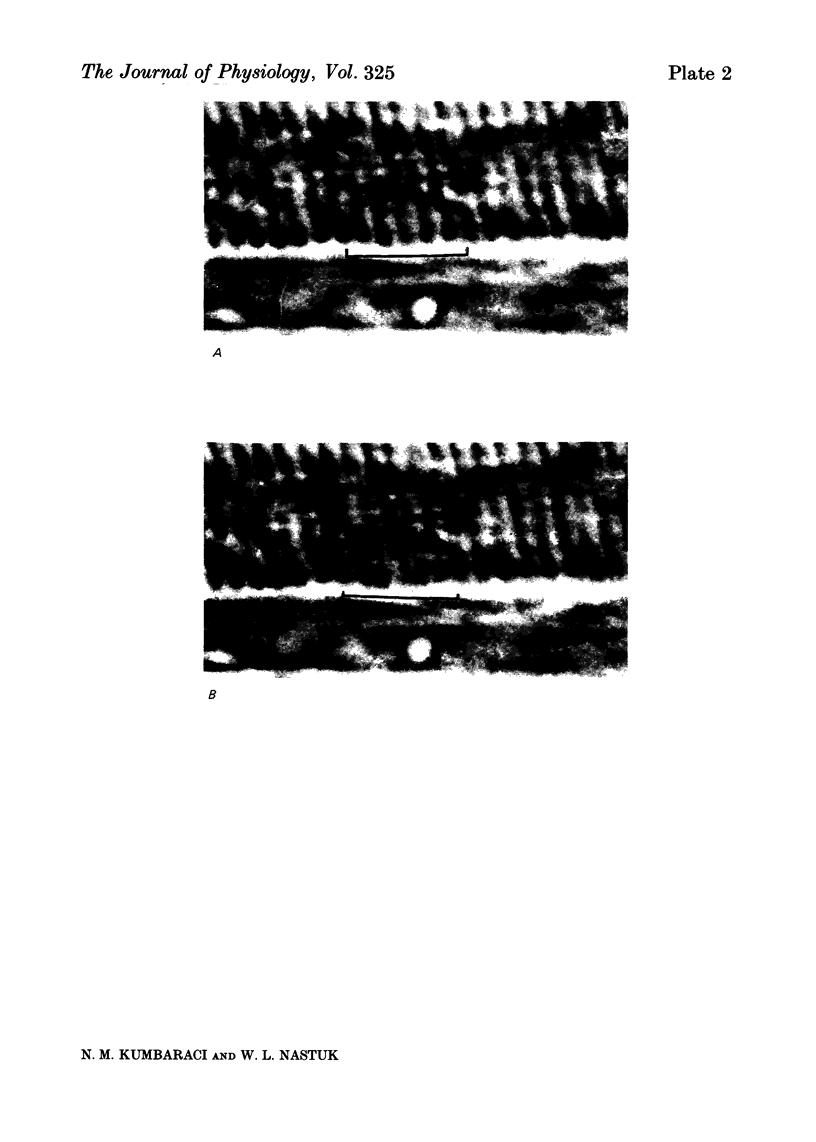
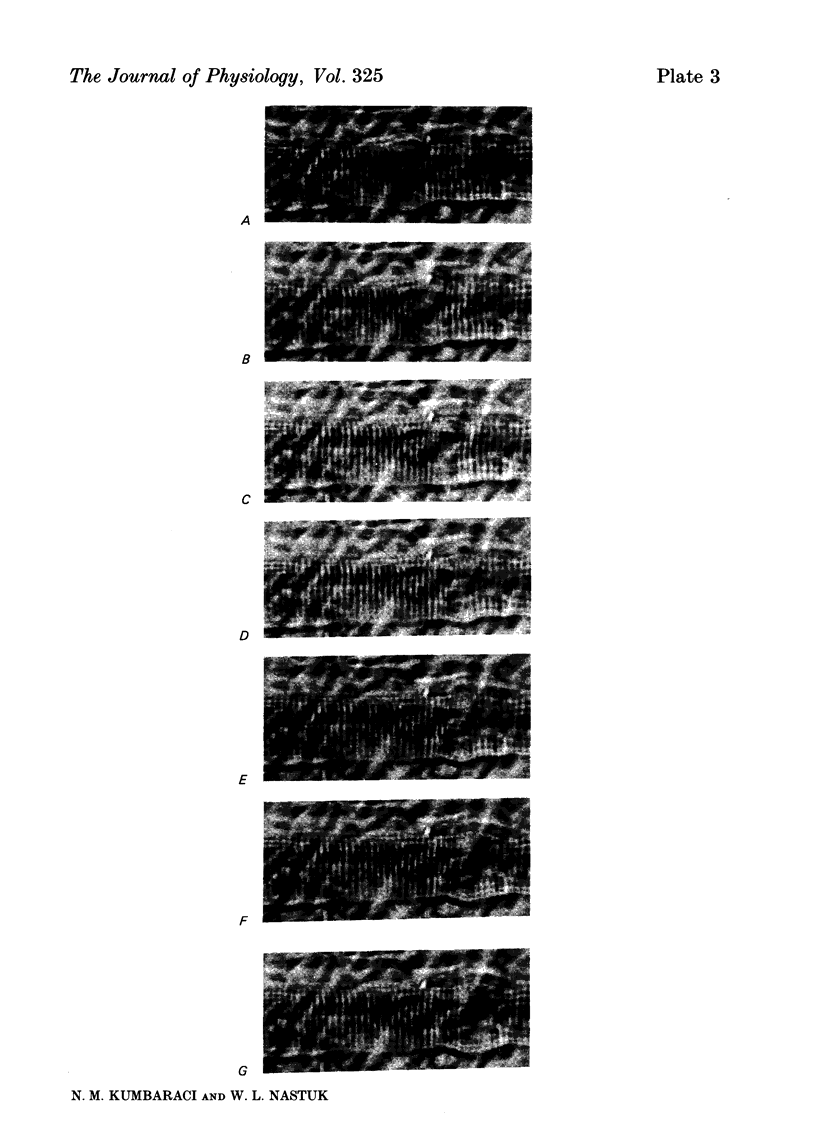
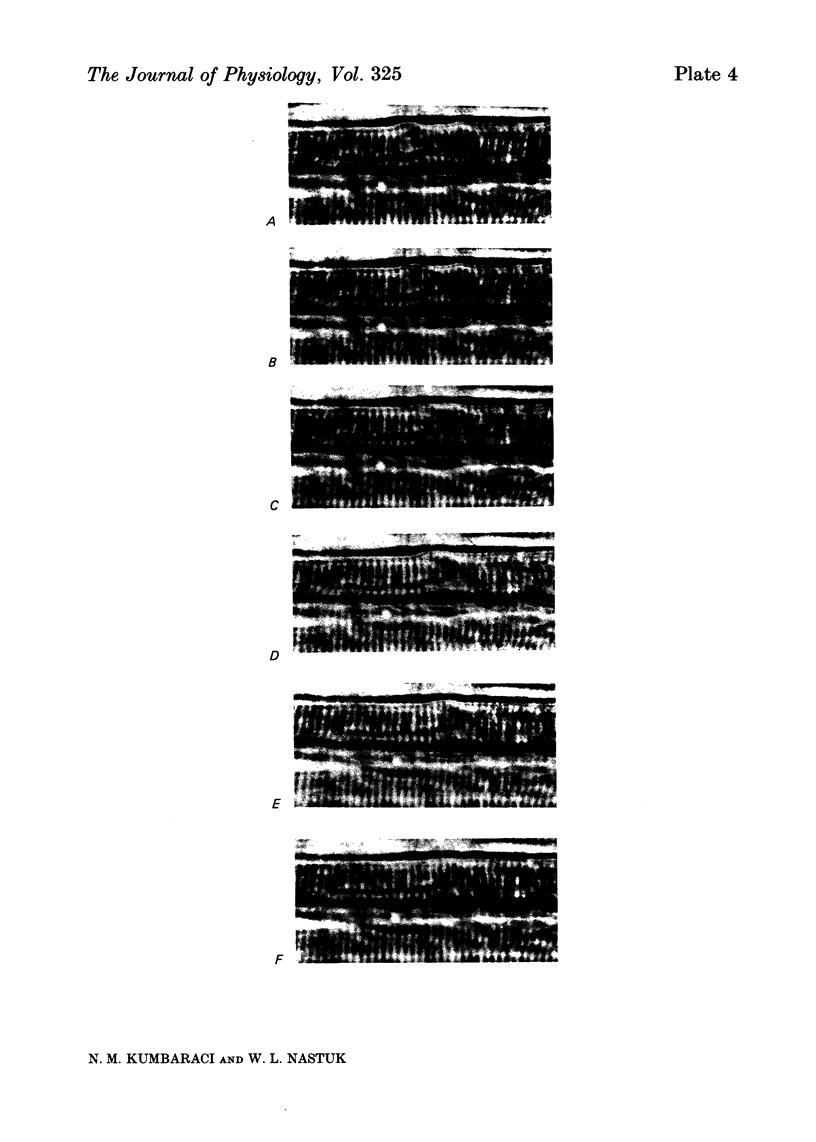
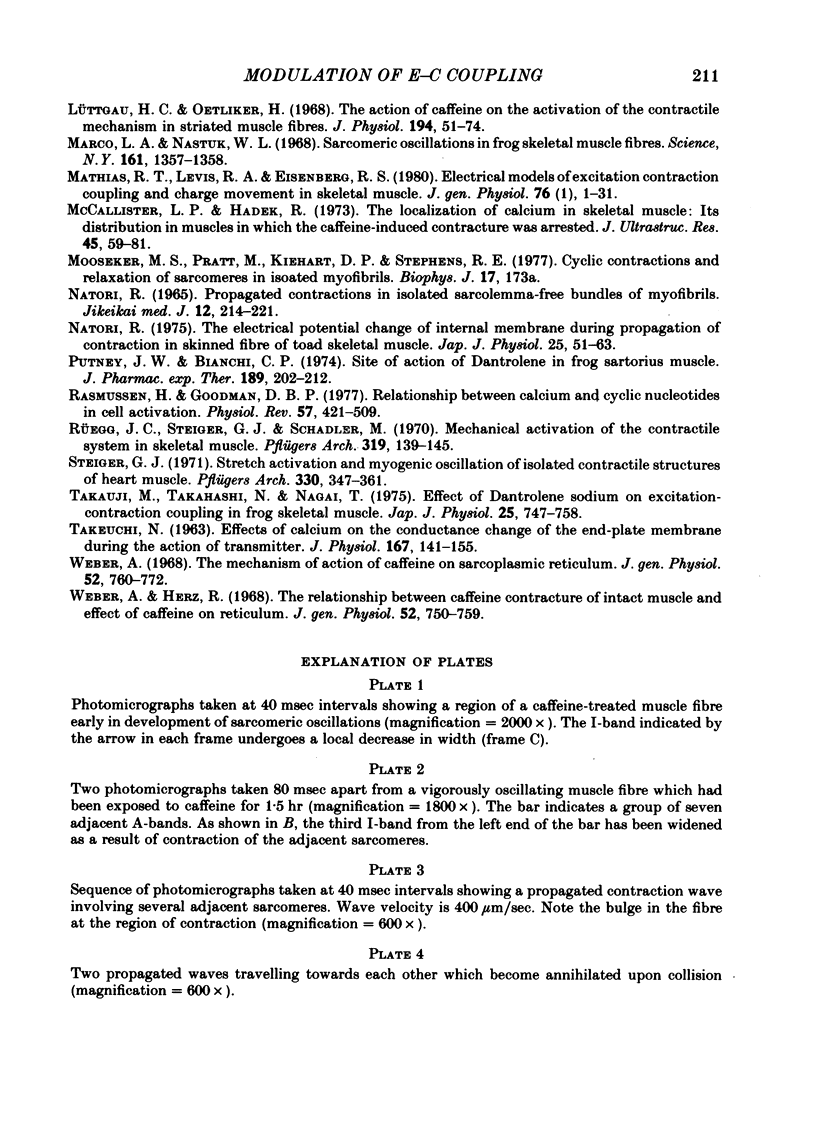
Images in this article
Selected References
These references are in PubMed. This may not be the complete list of references from this article.
- AXELSSON J., THESLEFF S. Activation of the contractile mechanism in striated muscle. Acta Physiol Scand. 1958 Oct 28;44(1):55–66. doi: 10.1111/j.1748-1716.1958.tb01608.x. [DOI] [PubMed] [Google Scholar]
- BIANCHI C. P. Kinetics of radiocaffeine uptake and release in frog sartorius. J Pharmacol Exp Ther. 1962 Oct;138:41–47. [PubMed] [Google Scholar]
- Bianchi C. P. Pharmacological actions on excitation-contraction coupling in striated muscle. Fed Proc. 1968 Jan-Feb;27(1):126–131. [PubMed] [Google Scholar]
- Brocklehurst L. Letter: Dantrolene sodium and "skinned" muscle fibres. Nature. 1975 Mar 27;254(5498):364–364. doi: 10.1038/254364a0. [DOI] [PubMed] [Google Scholar]
- CALDWELL P. C., WALSTER G. STUDIES ON THE MICRO-INJECTION OF VARIOUS SUBSTANCES INTO CRAB MUSCLE FIBRES. J Physiol. 1963 Nov;169:353–372. doi: 10.1113/jphysiol.1963.sp007261. [DOI] [PMC free article] [PubMed] [Google Scholar]
- Chandler W. K., Rakowski R. F., Schneider M. F. Effects of glycerol treatment and maintained depolarization on charge movement in skeletal muscle. J Physiol. 1976 Jan;254(2):285–316. doi: 10.1113/jphysiol.1976.sp011233. [DOI] [PMC free article] [PubMed] [Google Scholar]
- Chiarandini D. J., Reuben J. P., Brandt P. W., Grundfest H. Effects of caffeine on crayfish muscle fibers. I. Activation of contraction and induction of Ca spike electrogenesis. J Gen Physiol. 1970 May;55(5):640–664. doi: 10.1085/jgp.55.5.640. [DOI] [PMC free article] [PubMed] [Google Scholar]
- Chiarandini D. J., Reuben J. P., Girardier L., Katz G. M., Grundfest H. Effects of caffeine on crayfish muscle fibers. II. Refractoriness and factors influencing recovery (repriming) of contractile responses. J Gen Physiol. 1970 May;55(5):665–687. doi: 10.1085/jgp.55.5.665. [DOI] [PMC free article] [PubMed] [Google Scholar]
- Coleman A. W., Coleman J. R., Griffin J. D., Weltman J. K., Chapman K. M. Methylxanthine-induced escalation: a propagated wave phenomenon observed in skeletal muscle developing in culture. Proc Natl Acad Sci U S A. 1972 Mar;69(3):613–616. doi: 10.1073/pnas.69.3.613. [DOI] [PMC free article] [PubMed] [Google Scholar]
- Desmedt J. E., Hainaut K. Dantrolene and A13187 ionophore: specific action on calcium channels revealed by the aequorin method. Biochem Pharmacol. 1979 Apr 1;28(7):957–964. doi: 10.1016/0006-2952(79)90286-7. [DOI] [PubMed] [Google Scholar]
- Edman K. A., Elzinga G., Noble M. I. Enhancement of mechanical performance by stretch during tetanic contractions of vertebrate skeletal muscle fibres. J Physiol. 1978 Aug;281:139–155. doi: 10.1113/jphysiol.1978.sp012413. [DOI] [PMC free article] [PubMed] [Google Scholar]
- Eisenberg R. S., Howell J. N., Vaughan P. C. The maintenance of resting potentials in glycerol-treated muscle fibres. J Physiol. 1971 May;215(1):95–102. doi: 10.1113/jphysiol.1971.sp009459. [DOI] [PMC free article] [PubMed] [Google Scholar]
- Ellis K. O., Bryant S. H. Excitation-contraction uncoupling in skeletal muscle by dantrolene sodium. Naunyn Schmiedebergs Arch Pharmacol. 1972;274(1):107–109. doi: 10.1007/BF00501011. [DOI] [PubMed] [Google Scholar]
- Endo M. Stretch-induced increase in activation of skinned muscle fibres by calcium. Nat New Biol. 1972 Jun 14;237(76):211–213. doi: 10.1038/newbio237211a0. [DOI] [PubMed] [Google Scholar]
- Endo M., Tanaka M., Ogawa Y. Calcium induced release of calcium from the sarcoplasmic reticulum of skinned skeletal muscle fibres. Nature. 1970 Oct 3;228(5266):34–36. doi: 10.1038/228034a0. [DOI] [PubMed] [Google Scholar]
- Fabiato A., Fabiato F. Myofilament-generated tension oscillations during partial calcium activation and activation dependence of the sarcomere length-tension relation of skinned cardiac cells. J Gen Physiol. 1978 Nov;72(5):667–699. doi: 10.1085/jgp.72.5.667. [DOI] [PMC free article] [PubMed] [Google Scholar]
- Franzini-Armstrong C., Venosa R. A., Horowicz P. Morphology and accessibility of the 'transverse' tubular system in frog sartorius muscle after glycerol treatment. J Membr Biol. 1973;14(3):197–212. doi: 10.1007/BF01868078. [DOI] [PubMed] [Google Scholar]
- HODGKIN A. L., HOROWICZ P. Potassium contractures in single muscle fibres. J Physiol. 1960 Sep;153:386–403. doi: 10.1113/jphysiol.1960.sp006541. [DOI] [PMC free article] [PubMed] [Google Scholar]
- HODGKIN A. L., HOROWICZ P. The effect of nitrate and other anions on the mechanical response of single muscle fibres. J Physiol. 1960 Sep;153:404–412. doi: 10.1113/jphysiol.1960.sp006542. [DOI] [PMC free article] [PubMed] [Google Scholar]
- HUXLEY A. F., TAYLOR R. E. Local activation of striated muscle fibres. J Physiol. 1958 Dec 30;144(3):426–441. doi: 10.1113/jphysiol.1958.sp006111. [DOI] [PMC free article] [PubMed] [Google Scholar]
- Kao C. Y., Stanfield P. R. Actions of some anions on electrical properties and mechanical threshold of frog twitch muscle. J Physiol. 1968 Sep;198(2):291–309. doi: 10.1113/jphysiol.1968.sp008607. [DOI] [PMC free article] [PubMed] [Google Scholar]
- Lüttgau H. C., Oetliker H. The action of caffeine on the activation of the contractile mechanism in straited muscle fibres. J Physiol. 1968 Jan;194(1):51–74. doi: 10.1113/jphysiol.1968.sp008394. [DOI] [PMC free article] [PubMed] [Google Scholar]
- Marco L. A., Nastuk W. L. Sarcomeric oscillations in frog skeletal muscle fibers. Science. 1968 Sep 27;161(3848):1357–1358. doi: 10.1126/science.161.3848.1357. [DOI] [PubMed] [Google Scholar]
- Mathias R. T., Levis R. A., Eisenberg R. S. Electrical models of excitation-contraction coupling and charge movement in skeletal muscle. J Gen Physiol. 1980 Jul;76(1):1–31. doi: 10.1085/jgp.76.1.1. [DOI] [PMC free article] [PubMed] [Google Scholar]
- McCallister L. P., Hadek R. The localization of calcium in skeletal muscle: its distribution in muscles in which the caffeine-induced contracture was arrested. J Ultrastruct Res. 1973 Oct;45(1):59–81. doi: 10.1016/s0022-5320(73)90033-6. [DOI] [PubMed] [Google Scholar]
- Natori R. The electric potential change of internal membrane during propagation of contraction in skinned fibre of toad skeletal muscle. Jpn J Physiol. 1975;25(1):51–63. doi: 10.2170/jjphysiol.25.51. [DOI] [PubMed] [Google Scholar]
- Putney J. W., Biancri C. P. Site of action of dantrolene in frog sartorius muscle. J Pharmacol Exp Ther. 1974 Apr;189(1):202–212. [PubMed] [Google Scholar]
- Rasmussen H., Goodman D. B. Relationships between calcium and cyclic nucleotides in cell activation. Physiol Rev. 1977 Jul;57(3):421–509. doi: 10.1152/physrev.1977.57.3.421. [DOI] [PubMed] [Google Scholar]
- Rüegg J. C., Steiger G. J., Schädler M. Mechanical activation of the contractile system in skeletal muscle. Pflugers Arch. 1970;319(2):139–145. doi: 10.1007/BF00592492. [DOI] [PubMed] [Google Scholar]
- Steiger G. J. Stretch activation and myogenic oscillation of isolated contractile structures of heart muscle. Pflugers Arch. 1971;330(4):347–361. doi: 10.1007/BF00588586. [DOI] [PubMed] [Google Scholar]
- TAKEUCHI N. Effects of calcium on the conductance change of the end-plate membrane during the action of transmitter. J Physiol. 1963 Jun;167:141–155. doi: 10.1113/jphysiol.1963.sp007137. [DOI] [PMC free article] [PubMed] [Google Scholar]
- Takauji M., Takahashi N., Nagai T. Effect of dantrolene sodium on excitation-contraction coupling in frog skeletal muscle. Jpn J Physiol. 1975;25(6):747–758. doi: 10.2170/jjphysiol.25.747. [DOI] [PubMed] [Google Scholar]
- Weber A., Herz R. The relationship between caffeine contracture of intact muscle and the effect of caffeine on reticulum. J Gen Physiol. 1968 Nov;52(5):750–759. doi: 10.1085/jgp.52.5.750. [DOI] [PMC free article] [PubMed] [Google Scholar]
- Weber A. The mechanism of the action of caffeine on sarcoplasmic reticulum. J Gen Physiol. 1968 Nov;52(5):760–772. doi: 10.1085/jgp.52.5.760. [DOI] [PMC free article] [PubMed] [Google Scholar]



